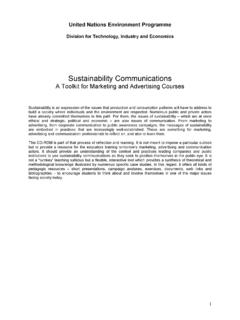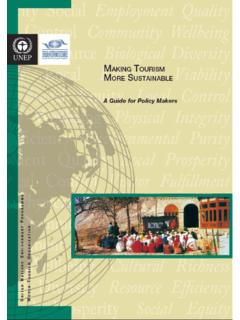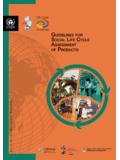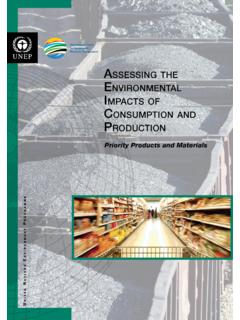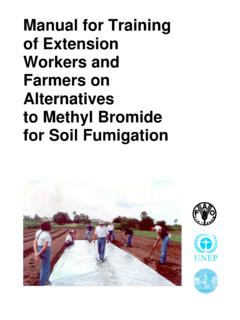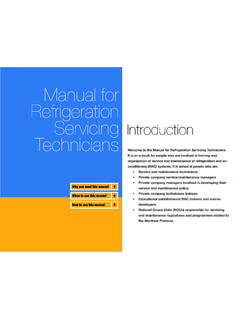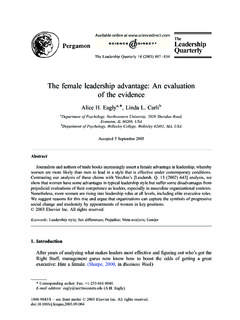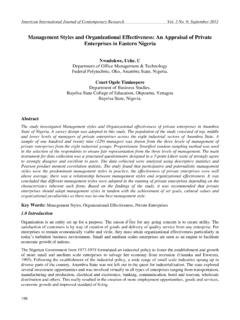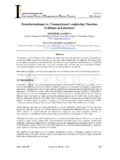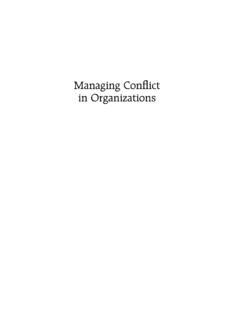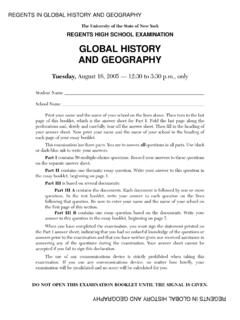Transcription of Life Cycle Management - unep.fr
1 Life Cycle ManagementHow business uses it to decrease footprint, create opportunities and make value chains more sustainableWho should read this issue brief?This issue brief can be given to company in-house experts and non-specialist managers as well as company suppliers so that they can learn how to apply life Cycle Management practices throughout the value chain. This is a very practical guide that can be read by all managers and employees from those at the front line working directly with suppliers, to people on the production line or in the warehouse, or staff dealing with marketing, design and development. What is vital (as the case studies underline) is that the message of sustainability and the concept of life Cycle Management spread out along the value chain both inside and outside the does this issue brief cover?
2 This issue brief gives a clear and practical introduction to life Cycle Management by:Explaining key concepts in plain language Giving real-life examples of how businesses put these concepts into practiceOutlining why life Cycle Management business practices are so important to businessesDescribing some of the key tools that businesses can useProviding a list of resources that readers can use to find more information on sustainable business practicesDiscussing a way forward for businesses towards the vision of the sustainable value this documentWhy read this issue brief?This issue brief outlines a business approach that goes beyond short-term success and aims at long-term value creation: life Cycle Management . It gives examples of how global businesses are using it to reduce, for instance, their products carbon, material and water footprints, as well as improve the social and economic performance of their offerings in order to ensure a more sustainable value chain.
3 These efforts improve a company s performance, strengthen corporate credibility and stakeholder relations and enhance shareholder value. Traditionally, the focus on improving production conditions has been at a local level. Today, as more products (goods and services) are traded regionally and globally, we need international initiatives that incorporate life Cycle thinking and approaches to help businesses respond to the challenges posed by today s global marketplace. Life Cycle ManagementHow business uses it to decrease footprint, create opportunities and make value chains more sustainableiAcknowledgementsProducer This Guide has been produced by UNEP and Winifred Power, Power EditingSupervision, technical editing and support UNEP DTIE (Sonia Valdivia, Guido Sonnemann), SETAC (Michael Mozur), Gerald Rebitzer (Alcan Packaging), Allan Jensen (Force Technology) and Brigitte Monsou (ADDE).
4 ContributorsAtherton, John, ICMM; Fava, James, Five Winds International; Jensen, Allan, Force Technology; Mozur, Michael, SETAC; Sandberg, Per, WBCSD; Rebitzer, Gerald, Alcan Packaging; Sonnemann, Guido, UNEP DTIE; Swarr, Tom (former UTC); Tantawy Monsou, Brigitte, ADDE; Valdivia, Sonia, UNEP DTIEE ditingPower Editing, IrelandDesignJDK Design, IrelandPhotography Most of the pictures were purchased from iStockphotoContributions UNEP and SETAC would like to thank everybody who has contributed to this Issue Brief providing valuable background, ideas, and comments, especially the contributors and the companies who provided examples: Dora Almassy (Veolia), Emmanuelle Aoustin (Veolia), Gina Downes (Eskom), Lienne Carla Pires (3M), Gerald Rebitzer (Alcan Packaging), David Russell (Dow), Wulf-Peter Schmidt (Ford of Europe), Wayne Wnuck (UTC).
5 Thanks also to Bernard Mazjin, Ghent University for their iiAcronyms ivForeword vExecutive summary viiSo what is life Cycle Management ? vii1 The business case for life Cycle Management 1 Sustainability and the bottom line 1 Who is on board? 2 What sustainability approaches can companies use? 2 Working with suppliers and outsourcing 22 Defining the terms 3 What is a value chain? 4 What is life Cycle Management ? 4 What is life Cycle assessment? 4 What is social life Cycle assessment? 5 What is life Cycle costing? 6 What is the capability maturity model? 7 What is the footprint ? 7 What is resource efficiency? 103 Company case studies 113M 11 Alcan Packaging 14 The Dow Chemical Company 16 Eskom 18 Ford of Europe 20 United Technologies Corporation (UTC) 22 Veolia Environnement 234 Applying life Cycle Management to create value 255 The way forward 27 UNEP, SETAC, industry partners and their common vision 27A way forward for companies 286 The partnership 307 Training tools and publications 32 UNEP and SETAC training tools and publications 32 Other training tools and publications 33iiiAcronymsASSETT Alcan Sustainability Stewardship Evaluation ToolCMM capability maturity modelEHS environmental.
6 Health and safetyGHG greenhouse gas ISO International Organization for Standardization LCA life Cycle assessmentLCC life Cycle costingLCM life Cycle managementLEED leadership in Energy and Environmental Design MOC materials of concernNGO non-governmental organizationPD product developmentPSI product sustainability indexR&D Research and DevelopmentSCP sustainable consumption and productionSETAC Society of Environmental Toxicology and ChemistryS-LCA social life Cycle assessmentUNEP DTIE United Nations Environment Programme, Division of Technology, Industry and EconomicsWBCSD World Business Council for Sustainable DevelopmentWRI World Resources InstituteivForewordUNEPThe growing attention to life Cycle issues is a natural outcome of decades of UNEP work on cleaner production and ecoefficient industrial systems.
7 It is a next step in broadening the horizons of pollution prevention a process that has gone from a focus on production processes, to products, and then to product systems and sustainable innovation (new products, product systems and enterprises designed for win-win solutions for business, the environment and the people). Achim Steiner, Executive Director, UNEPQ uoted from the foreword of the Life Cycle Management A Business Guide to Sustainability , UNEP/SETAC the current partnership among SETAC, UNEP, and all of the sponsors of the UNEP/SETAC Life Cycle Initiative, we have had several successful years laying the foundation to move life Cycle thinking and approaches to another level. Continuing in this spirit, this valuable collaboration between UNEP and SETAC is a further demonstration of the importance of strong partnerships between key organizations in making the economic and environmental case for life Cycle thinking, assessment and Management to key business leaders and decision-makers.
8 It highlights too the potential such collaboration holds for the future. This is a small step towards building greater understanding of life Cycle approaches and their value towards creating more sustainable Management of our value chains. Our aim is to inspire organizations and firms to understand their value chains and then take actions collectively to reduce their footprint and improve their overall performance. Michael Mozur, Executive Director, SETACvSustainability is an emerging and evolving concept used with increasing frequency in today s globalized business world. Every day, corporate decision-makers grapple with their company s impact on the environment, natural resources and society in addition to tackling questions of economics. At the forefront of their minds is the need to answer the critical question of how to guarantee more sustainable business practices into the future to reduce their company s ecological footprint and increase their resource efficiency and productivity so that resources are not unnecessarily depleted or permanently damaged and still ensure a sufficient profit and the creation of social , how can companies spread the message of sustainability to employees, suppliers and customers throughout the product and value chain to promote more sustainable products and business practices into the future?
9 Life Cycle Management is one answer. The business case for achieving sustainable development rests on how it affects the bottom line. Life Cycle Management is a business approach that can be used to achieve sustainable development as it goes beyond short-term success and aims at long-term value creation. Global businesses are using it to reduce, for instance, their products carbon, material and water footprints, as well as improve the social and economic performance of their offerings in order to ensure a more sustainable value chain. These efforts improve a company s performance, strengthen corporate credibility and stakeholder relations and enhance shareholder value, both on a local and global level. Companies that meet the sustainability challenge will have the edge over their competitors that do not heed this challenge those that offer consumers what they want now and in the future are guaranteeing their own futures.
10 So what is life Cycle Management ?Life Cycle Management is a business Management approach that can be used by all types of businesses (and other organizations) to improve their products and thus the sustainability performance of the companies and associated value chains. A method that can be used equally by both large and small firms, its purpose is to ensure more sustainable value chain Management . It can be used to target, organize, analyze and manage product-related information and activities towards continuous improvement along the life summaryviiLife Cycle Management is about making life Cycle thinking and product sustainability operational for businesses that are aiming for continuous improvement. These are businesses that are striving towards reducing their footprints and minimizing their environmental and socio-economic burdens while maximizing economic and social values.
